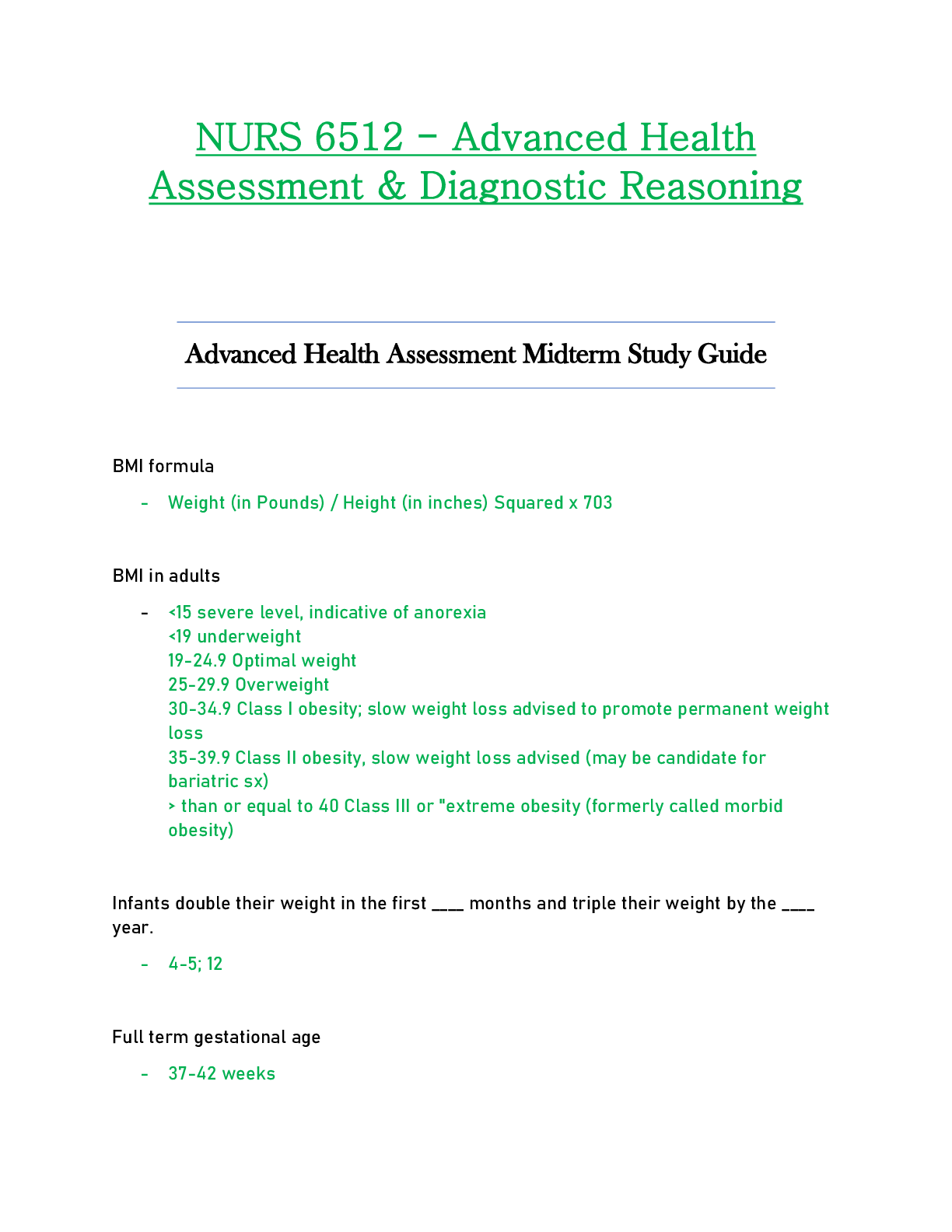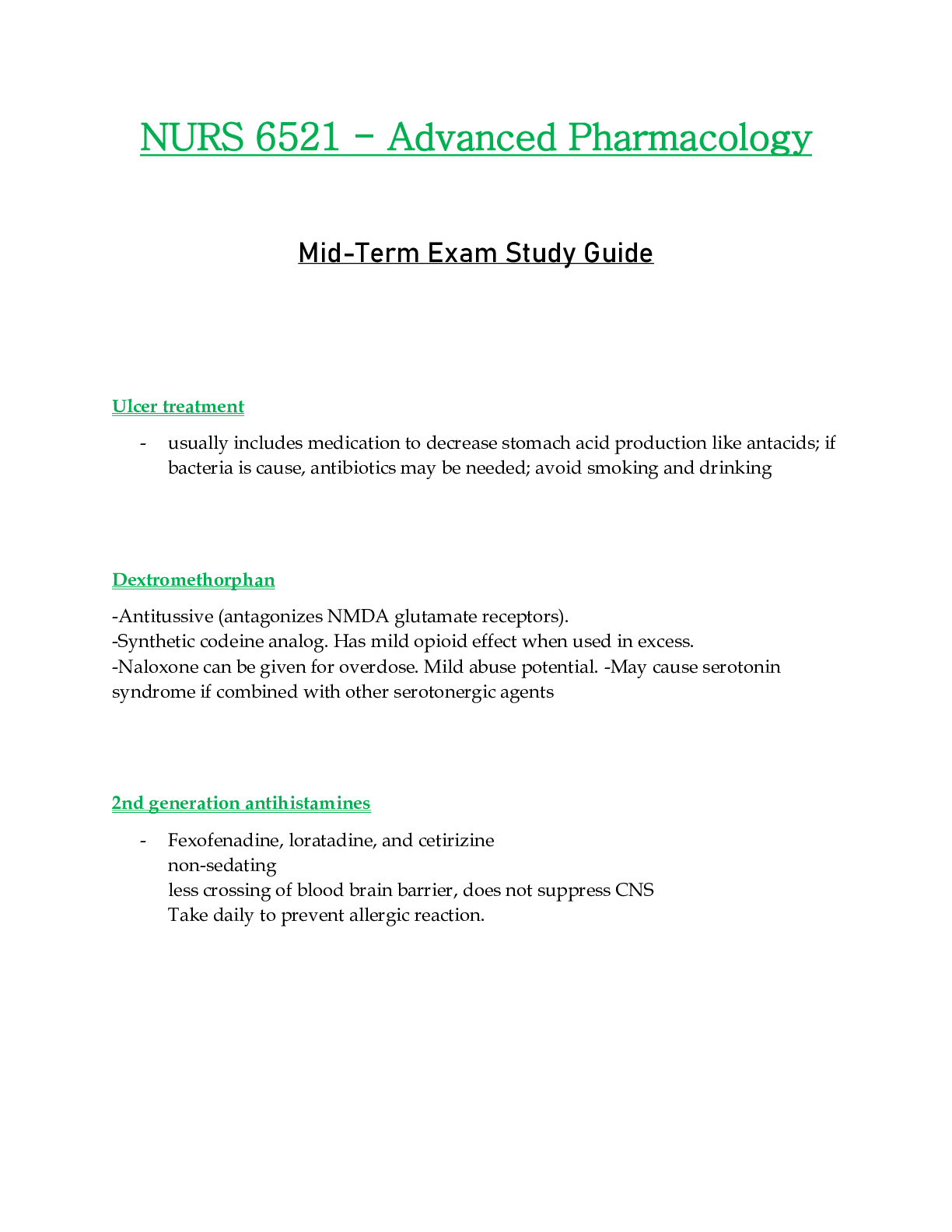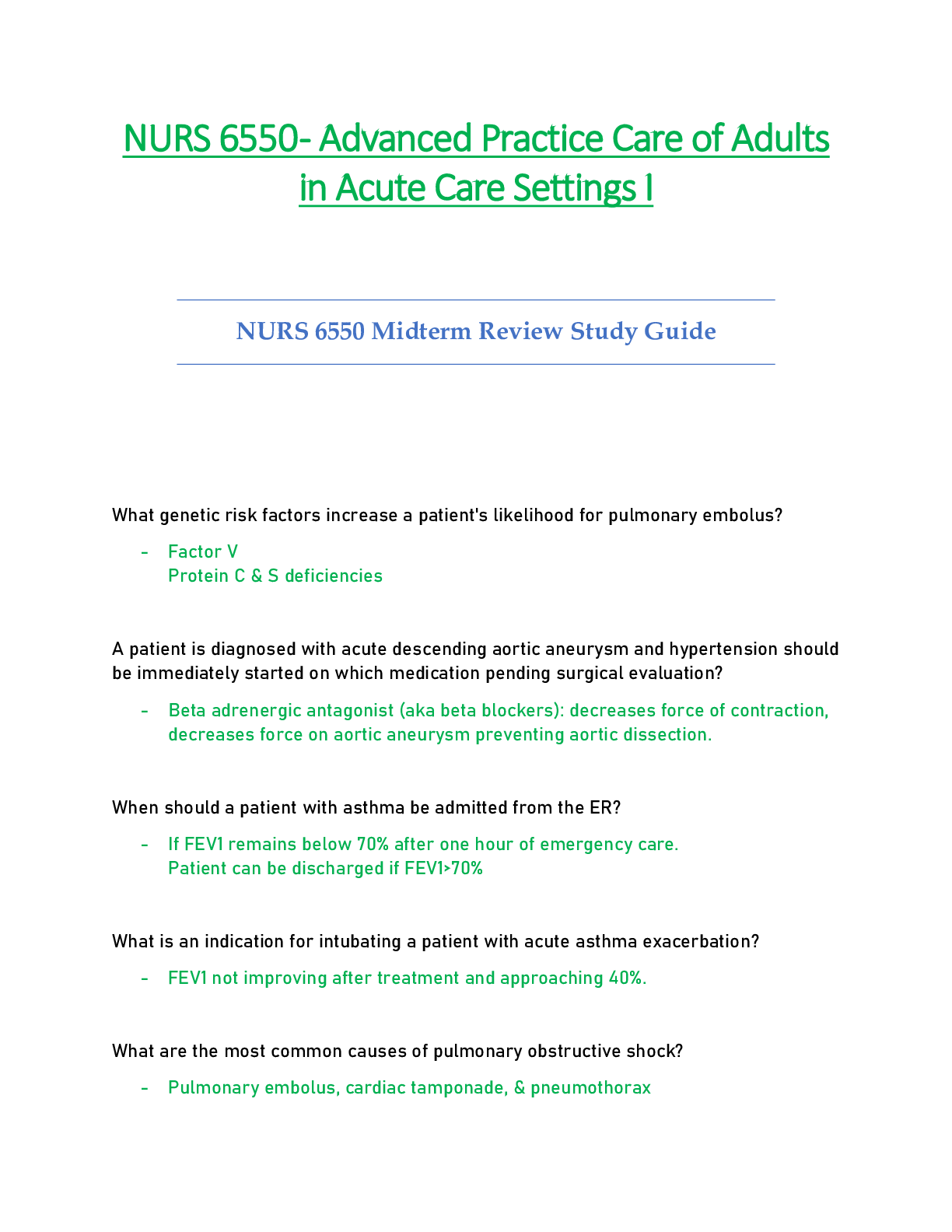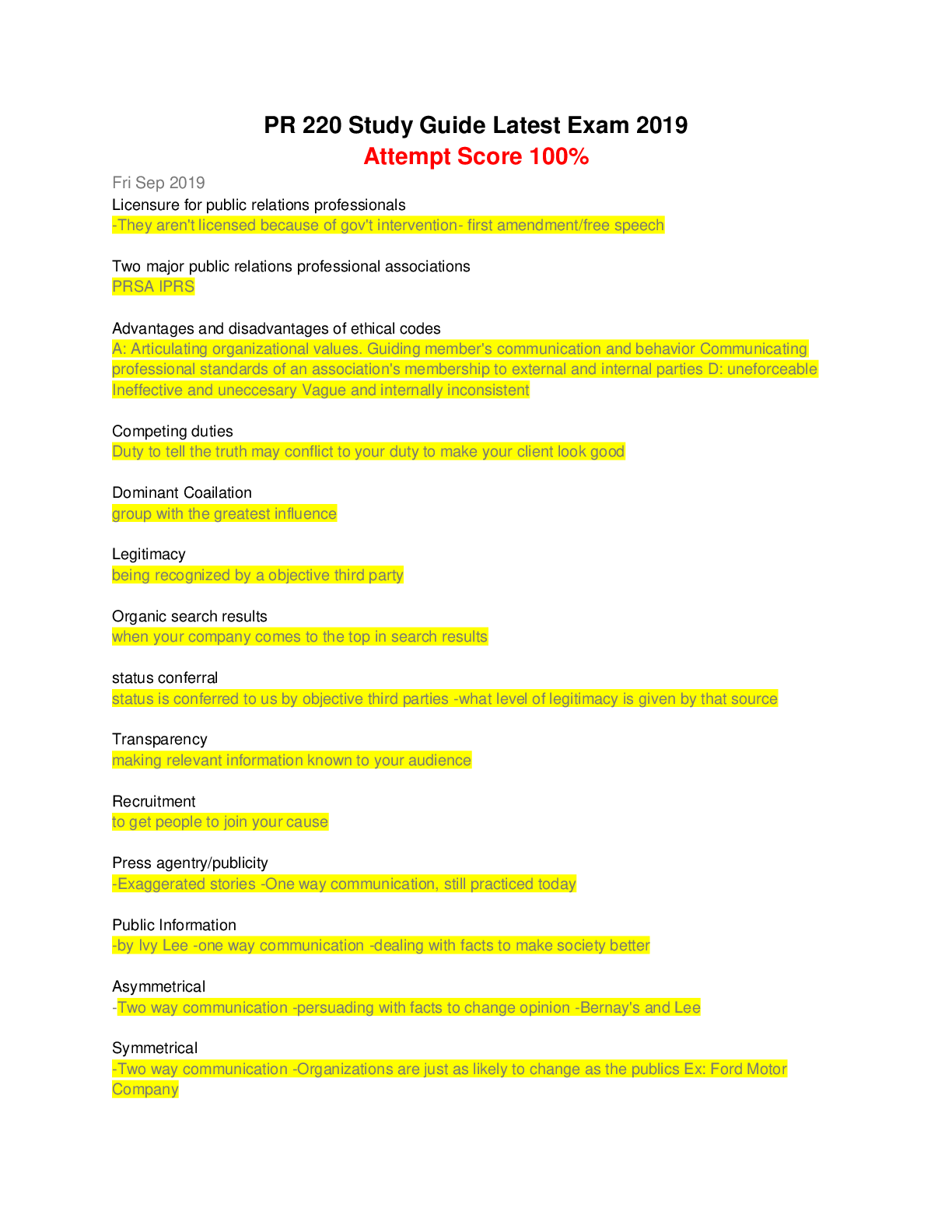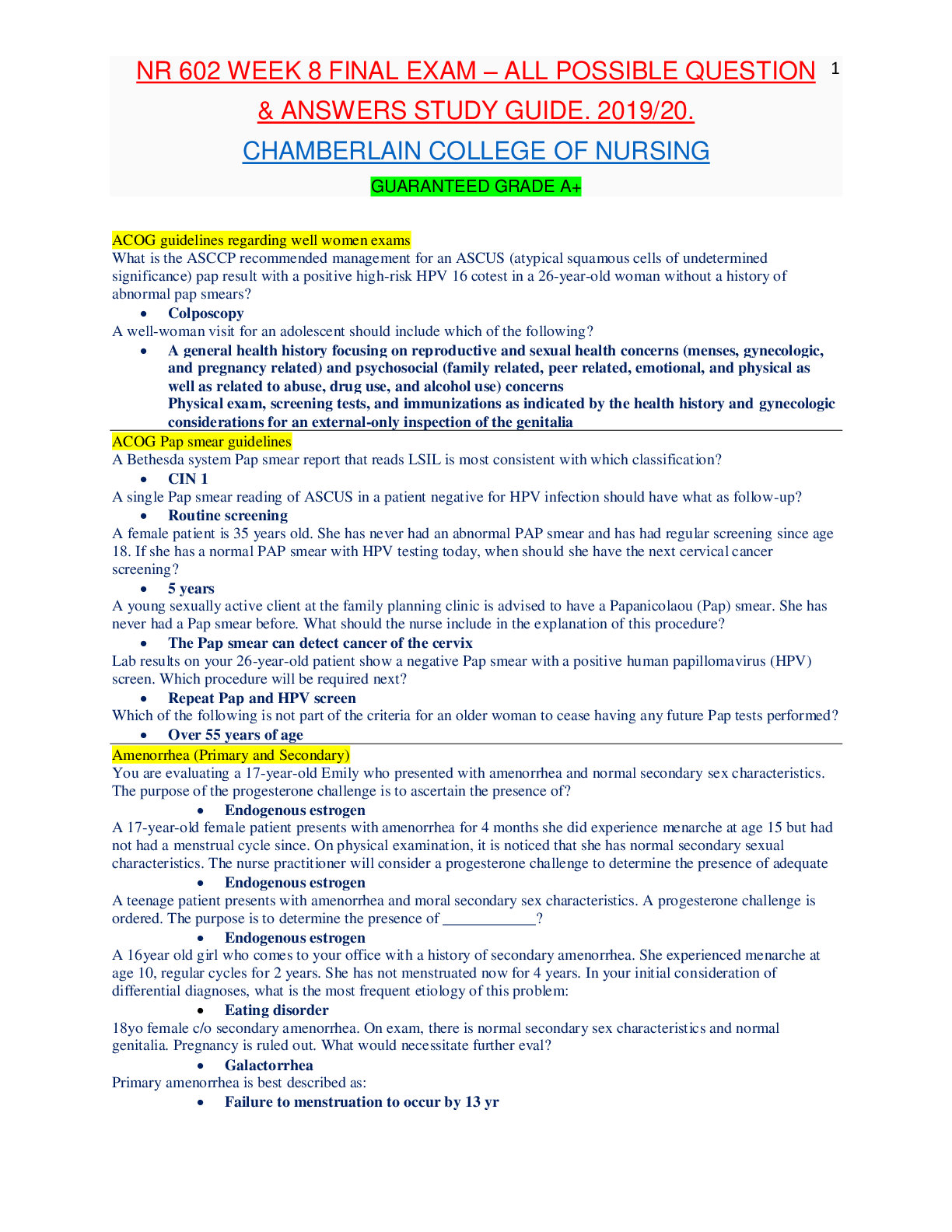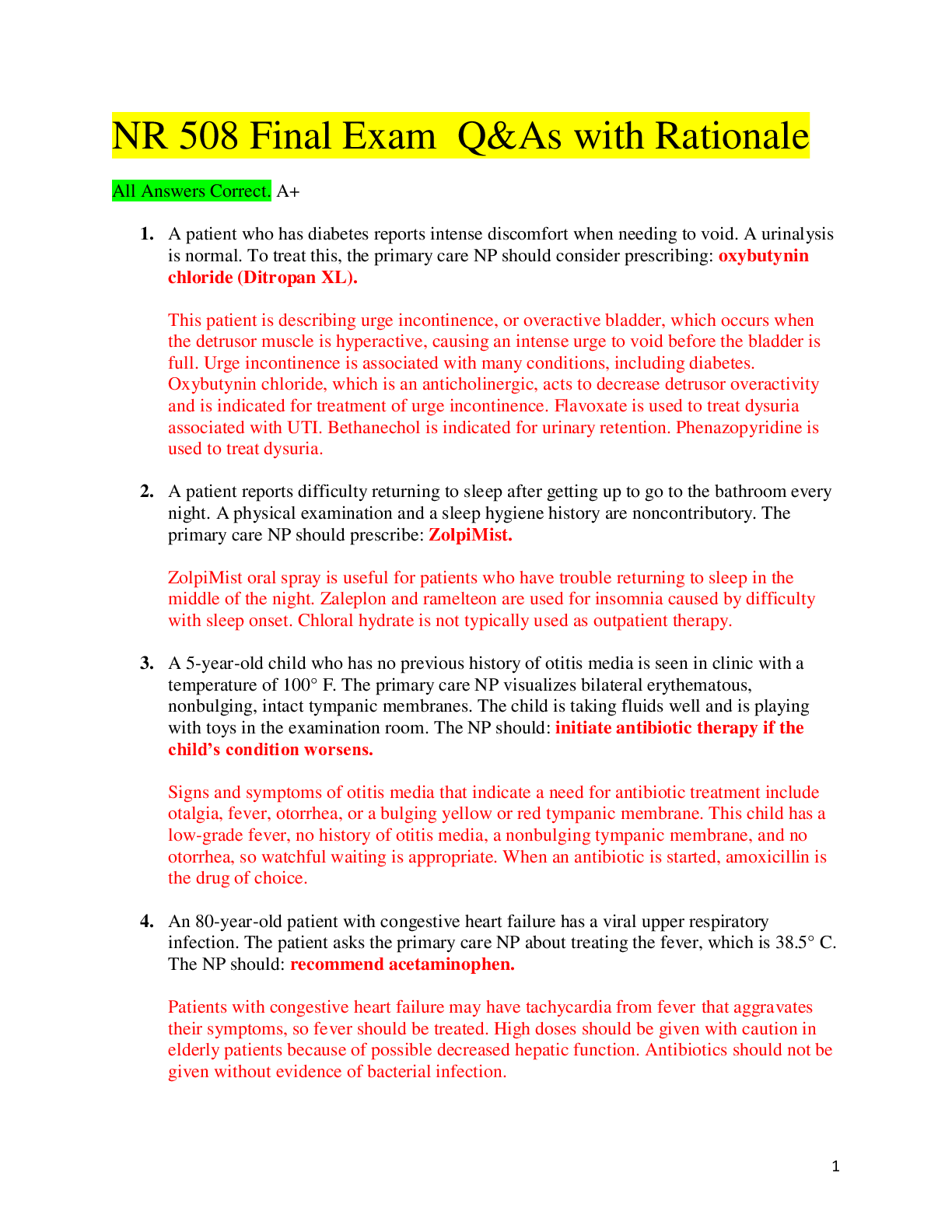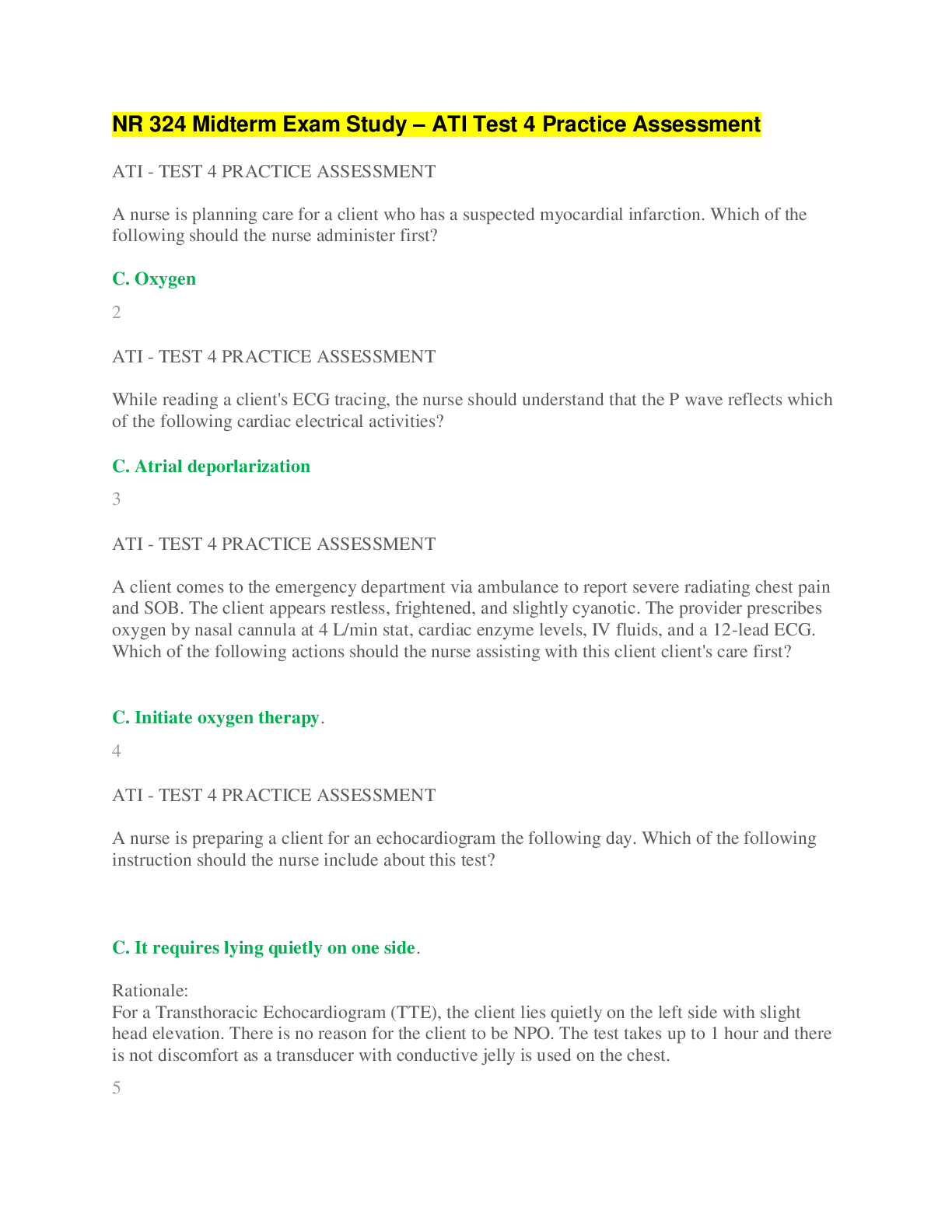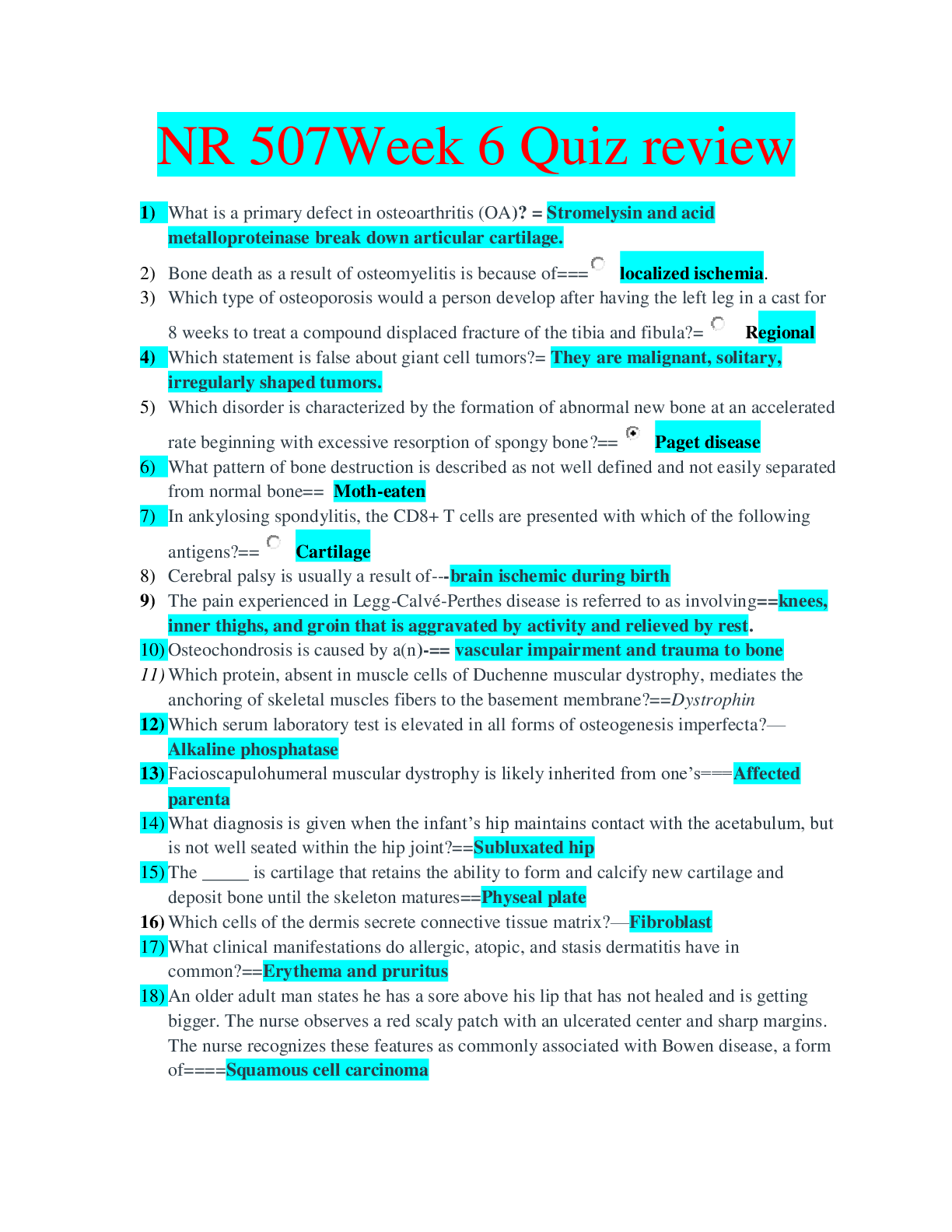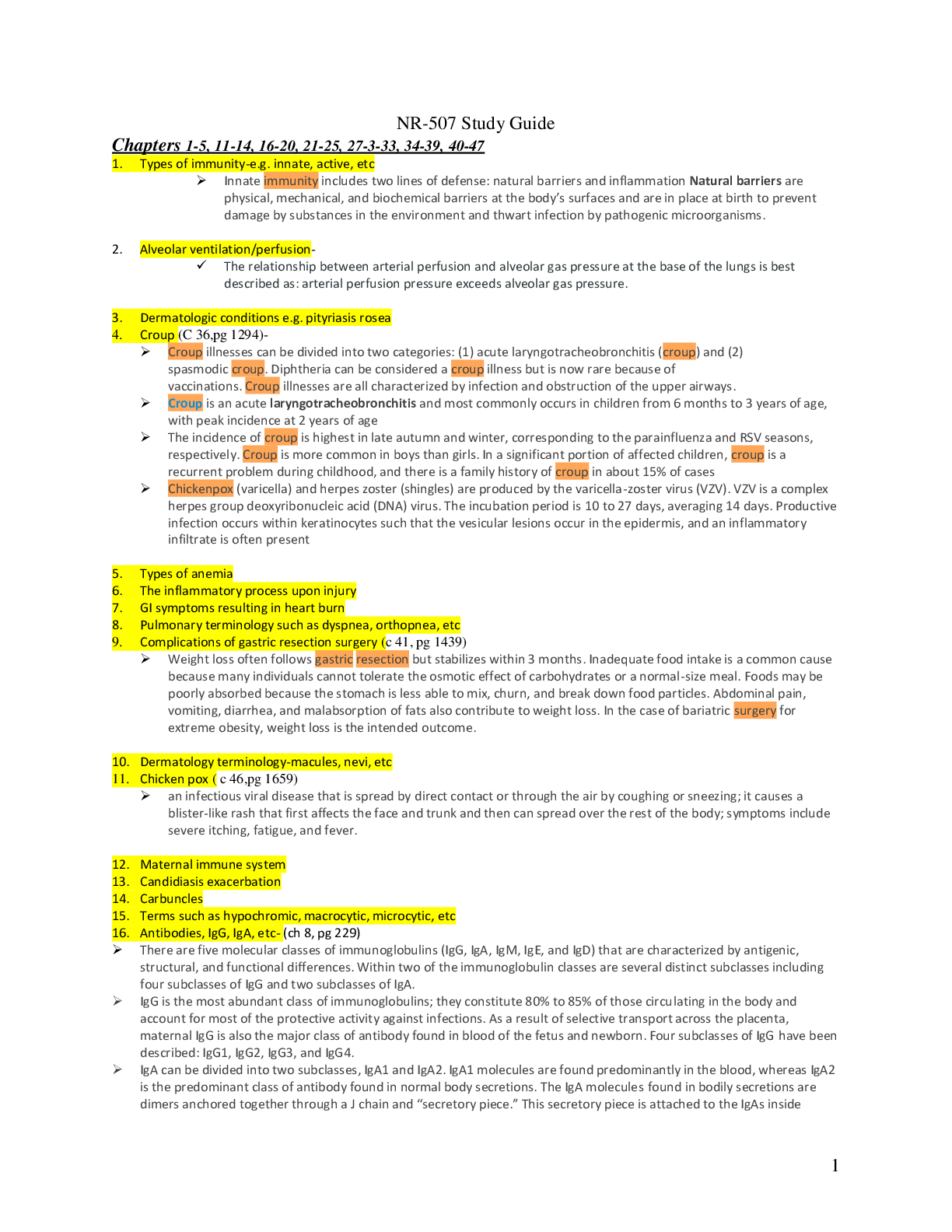*NURSING > STUDY GUIDE > NR511 / NR 511: Differential Diagnosis & Primary Care Practicum Final Exam Study Guide (Fall 2020) - (All)
NR511 / NR 511: Differential Diagnosis & Primary Care Practicum Final Exam Study Guide (Fall 2020) - Complete A solution_Chamberlain College of Nursing
Document Content and Description Below
1. Signs and symptoms and management of musculoskeletal sprains/strains/dislocations 16-15 When Maxwell, age 12, slid into home plate while playing baseball, he injured his ankle. The nurse pract... itioner is trying to differentiate between a sprain and a strain. A sprain A. is an injury to the ligaments that attach to bones in a joint. B. is an injury to the tendons that attach to the muscles in a joint. C. is an injury resulting in extensive tears of the muscles. D. is an injury th 16-98 Alexander, age 12, sprained his ankle playing ice hockey. He is confused as to whether to apply heat or cold. What should the nurse practitioner tell him? A. “Use continuous heat for the first 12 hours and then use heat or cold to your own preference.” B. “Use continuous cold for the fi rst 12 hours and then use heat or cold to your own preference.” C. “Apply cold for 20 minutes, then take it off for 30 to 45 minutes; repeat this for the fi rst 24 to 48 hours while awake.” D. “Alternate between cold and heat for 20 minutes each for the fi rst 24 to 48 hours.” 16-69 Ankylosis is defined as A. muscle shortening. B. joint stiffness. C. malposition of a joint. D. dislocation of a joint. 16-108 Jill, age 49, has recently begun a rigorous weight- lifting regimen. She presents to the primary care office with a shoulder dislocation. Which of the following clinical manifestations lead the nurse practitioner to suspect an anterior shoulder dislocation over a posterior dislocation? A. Inability to shrug the shoulder B. Absence of pain C. Inability to rotate the shoulder externally D. Shortening of the arm 16-123 In assessing an infant for developmental dysplasia of the hip (DDH), the practitioner places the infant supine, flexes the knees by holding the thumbs on the inner mid- thighs, with fingers outside on the hips touching the greater trochanters, stabilizes one hip, and abducts and gently pulls anteriorly on the other thigh. If this external rotation feels smooth with no sound present, there is no hip dislocation. This is A. the Allis test. B. Lasègue’s sign. C. the McMurray test. D. the Ortolani maneuver. 16-124 Emily, age 12, presents to the clinic with another muscle strain from one of her many sports activities. The nurse practitioner thinks that the patient was probably never taught about health promotion and maintenance regarding physical activity. What information should be included in patient teaching? A. “After an activity, if any part hurts, apply ice for 20 minutes.” B. “You must first get in shape with a rigorous schedule of weight training, and then you can participate in any activity once you are physically fi t.” C. “After any strenuous activity, you must completely rest your muscles before beginning your next activity.” D. “Stretching and warm- up exercises are an important part of any exercise routine.” 16-27 Upon assessment, the nurse practitioner notes unilateral back pain that had an acute onset and increases when standing and bending. A straight- leg test is negative. The most likely differential diagnosis is A. herniated nucleus pulposus. B. muscle strain. C. osteoarthritis. D. spondylolisthesis. 16-67 June, age 67, presents with back pain with no precipitating event. The pain is located over her lower back and muscles without sciatica, and it is aggravated by sitting, standing, and certain movements. It is alleviated with rest. Palpation localizes the pain, and muscle spasms are felt. There was an insidious onset with progressive improvement. What is the most likely differential diagnosis? A. Ankylosing spondylitis B. Musculoskeletal strain C. Spondylolisthesis D. Herniated disk 2. Signs and symptoms and management of spinal disorders (spondylosis, stenosis, etc.) 6-79 Sam, age 73, has lumbar spinal stenosis and asks which exercises he should do to help his condition. You advise him to A. do any exercise that results in hyperextension of the lumbar spine. B. do exercises that encourage lumbar flexion and flattening of the lumbar lordotic curve. C. refrain from exercising. D. see a surgeon because surgery is the best treatment option. 7-57 Clients with spinal cord injuries often have bowel incontinence and need to have a bowel program instituted. What is the most effective way to stimulate the rectum to evacuate in the quadriplegic client? A. Administer stool softeners every night. B. Insert a rectal suppository and then eventually perform digital stimulation. C. Administer laxatives every other night. D. Administer enemas on a regular basis. 13-12 Decreased bladder capacity; bladder irritation from a urinary tract infection, tumor, stones, or irritants such as caffeine and alcohol; and central nervous system disorders or spinal cord lesions are all contributing factors to A. stress urinary incontinence. B. urge urinary incontinence. C. overflow urinary incontinence. D. reflex urinary incontinence. 16-50 Beth, age 49, comes in with low back pain. An x- ray of the lumbar/sacral spine is within normal limits. Which of the following diagnoses do you explore further? A. Scoliosis B. Osteoarthritis C. Spinal stenosis D. Herniated nucleus pulposus 16-72 Hilda, age 73, presents with a complaint of low back pain. Red flags in her history of a minor fall, osteopenia, and prolonged steroid use for systemic lupus erythematosus suggest the possibility of which of the following serious underlying conditions as the cause of her low back pain? A. Cancer B. Cauda equina syndrome D spinal fracture 16-14 Mrs. Kelly, age 80, has a curvature of the spine. This is likely to indicate which age- related change? A. Lordosis B. Dorsal kyphosis C. Scoliosis D. Kyphoscoliosis 16-90 What disorder affects older individuals, particularly women, and is characterized by pain and stiffness in the cervical spine and shoulder and hip girdles, along with signs of systemic infection such as malaise, weight loss, sweats, and low- grade fever? A. Fibromyalgia syndrome B. Myofascial somatic dysfunction C. Polymyalgia rheumatica D. Reiter’s syndrome 3. Recognition and immediate management of cauda equina syndrome 16-11 The most common cause of cauda equina syndrome is A. fracture. B. hematoma. C. lumbar intervertebral disk herniation. D. space- occupying lesion. 16-60 Sandy, age 49, presents with loss of anal sphincter tone, impaired micturition, incontinence, and progressive loss of strength in the legs. You suspect cauda equina syndrome. What is your next action? A. Order physical therapy B. Order a lumbar/sacral x- ray C. Order extensive lab work D. Refer to a neurosurgeon 16-72 Hilda, age 73, presents with a complaint of low back pain. Red flags in her history of a minor fall, osteopenia, and prolonged steroid use for systemic lupus erythematosus suggest the possibility of which of the following serious underlying conditions as the cause of her low back pain? A. Cancer B. Cauda equina syndrome C. Neurological compromise D. Spinal fracture 4. Maneuvers and expected findings with joint pain (knee, shoulder, wrist, etc.) Chap 16 16-24 To aid in the diagnosis of meniscus damage, which test should a nurse practitioner perform? A. The bulge test B. The Lachman test C. The drawer test D. Apley’s compression test 16-35 You are assessing Jamal, age 16, after a football injury to his right knee. You elicit a positive anterior/posterior drawer sign. This test indicates an injury to the A. lateral meniscus. B. cruciate ligament. C. medial meniscus. D. collateral ligament. 16-29 The straight leg–raising maneuver can be used to diagnose A. nerve root compression. B. a fractured hip. C. an anterior cruciate ligament tear. D. tendinitis. 16-96 What is the name of the test used to assess for nerve- root compression? A. The Apley scratch test B. The drop arm test C. Finkelstein’s test D. Spurling’s maneuver 16-123 In assessing an infant for developmental dysplasia of the hip (DDH), the practitioner places the infant supine, flexes the knees by holding the thumbs on the inner mid- thighs, with fingers outside on the hips touching the greater trochanters, stabilizes one hip, and abducts and gently pulls anteriorly on the other thigh. If this external rotation feels smooth with no sound present, there is no hip dislocation. This is A. the Allis test. B. Lasègue’s sign. C. the McMurray test. D. the Ortolani maneuver. 5. Initial assessment of FOOSH injury in correlation to anatomical location of radial head bone 16-39 Margaret, age 55, presents to you for evaluation of left hand and wrist pain and swelling after a slip and fall on the ice yesterday. On examination, you note tenderness at her “anatomical snuffbox.” You knows this probably indicates a(n) A. ulnar styloid fracture. B. scaphoid fracture. C. hamate fracture. D. radial head fracture. 16-71 Anne, age 67, sustained a fall on an outstretched hand. She presents holding her arm against her chest with her elbow flexed. Based on the specific location of her pain, you suspect a radial head fracture. The best initial strategy to assess for radial head fracture would be A. to palpate for tenderness, swelling, and crepitus just distal to the lateral epicondyle. B. to palpate for tenderness, swelling, and crepitus along the radial wrist. C. to palpate for tenderness in the “anatomical snuffbox.” D. to order an x- ray of the wrist. 6. Assessment and management of Myofascial pain 16-90 What disorder affects older individuals, particularly women, and is characterized by pain and stiffness in the cervical spine and shoulder and hip girdles, along with signs of systemic infection such as malaise, weight loss, sweats, and low- grade fever? A. Fibromyalgia syndrome B. Myofascial somatic dysfunction C. Polymyalgia rheumatica D. Reiter’s syndrome Myofascial somatic dysfunction is described as impairments of the body framework. The impairments can affect joints, skeletal, and myofascial structures along with their related vascular, lymphatic, and neural function. 7. Health promotion activities to prevent sport related musculoskeletal injuries 16-16 Which of the following is NOT a management principal for an acute musculoskeletal injury that does not require emergent treatment? A. RICE B. NSAIDs or acetaminophen C. Imaging studies D. Skeletal muscle relaxants. 16-86 James, age 17, has been complaining of a painful knob below his right knee that has prevented him from actively participating in sports. He has recently been given a diagnosis of Osgood-Schlatter disease and asks you about his treatment options. The nurse practitioner should tell him that the initial treatment is A. relative rest; he could benefit from hamstring, heel cord, and quadricep stretching exercises. B. immobilization; a long- leg knee immobilizer is recommended. C. surgical intervention; removal of the bony fragments is necessary. D. bedrest for 1 week. 16-124 Emily, age 12, presents to the clinic with another muscle strain from one of her many sports activities. The nurse practitioner thinks that the patient was probably never taught about health promotion and maintenance regarding physical activity. What information should be included in patient teaching? A. “After an activity, if any part hurts, apply ice for 20 minutes.” B. “You must first get in shape with a rigorous schedule of weight training, and then you can participate in any activity once you are physically fit.” C. “After any strenuous activity, you must completely rest your muscles before beginning your next activity.” D. “Stretching and warm- up exercises are an important part of any exercise routine.”. 16-15 When Maxwell, age 12, slid into home plate while playing baseball, he injured his ankle. The nurse practitioner is trying to differentiate between a sprain and a strain. A sprain A. is an injury to the ligaments that attach to bones in a joint. B. is an injury to the tendons that attach to the muscles in a joint. C. is an injury resulting in extensive tears of the muscles. D. is an injury that does not result in joint instability. 16-98 Alexander, age 12, sprained his ankle playing ice hockey. He is confused as to whether to apply heat or cold. What should the nurse practitioner tell him? A. “Use continuous heat for the first 12 hours and then use heat or cold to your own preference.” B. “Use continuous cold for the first 12 hours and then use heat or cold to your own preference.” C. “Apply cold for 20 minutes, then take it off for 30 to 45 minutes; repeat this for the first 24 to 48 hours while awake.” D. “Alternate between cold and heat for 20 minutes each for the first 24 to 48 hours.” 8. Osteopenia 6-87 Shelley, 65 years old, sees you for the first time. She has demonstrated osteopenia on a bone density test, and you have prescribed the appropriate medication for her. What additional lifestyle changes should you counsel for this client? A. She should begin a rigorous swimming program to actively build bone. B. She should cut down on coffee, but tea is okay. C. She needs to take a multivitamin every day. D. She should begin weight training.. 12-51 Marisa, age 42, has celiac disease. She is prone to osteopenia bone disease as a result of impaired calcium absorption because of A. increased calcium absorption by the small intestine. B. increased absorption of the fat-soluble vitamin D. C. the binding of calcium and magnesium in the intestinal lumen by unabsorbed dietary fatty acids. D. decreased magnesium absorption. 15-90 Mrs. Thomas, age 69, comes to your office for the results of her DEXA scan. She reports that her mother had osteopenia before she died. The DEXA scan result shows a T score of −2.7 in the hip and −2.8 in the spine. You explain to her that her results show A. normal bone density. B. osteopenia. C. osteoporosis. 16-72 Hilda, age 73, presents with a complaint of low back pain. Red flags in her history of a minor fall, osteopenia, and prolonged steroid use for systemic lupus erythematosus suggest the possibility of which of the following serious underlying conditions as the cause of her low back pain? A. Cancer B. Cauda equina syndrome C. Neurological compromise D. Spinal fracture. 16-18 Lillian, age 70, was told that she has osteoporosis. When she asks you what this is, you respond that osteoporosis A. develops when loss of bone occurs more rapidly than new bone growth. B. is a degenerative joint disease characterized by loss of cartilage in certain joints. 16-40 Black men have a relatively low incidence of osteoporosis because they have A. increased bone resorption. B. a higher bone mass. C. wide and thick long bones. D. decreased bone deposition. 16-45 Joan, age 76, has been given a diagnosis of osteoporosis confirmed with a dual- energy x- ray absorptiometry (DEXA) scan. The nurse practitioner has educated her about the importance of increasing calcium and vitamin D in her diet and starting a low- impact, weight- bearing exercise program. The nurse practitioner is also going to start the patient on medial management. Joan asks about a drug called a “SERM” that she has heard has been shown in studies to prevent vertebral fractures. Which of the following pharmacological therapies for osteoporosis is classified as a selective estrogen receptor modulator (SERM)? A. Alendronate (Fosamax) B. Risedronate (Actonel) C. Salmon calcitonin D. Raloxifene (Evista) 16-32 Jennifer says that she has heard that caffeine can cause osteoporosis and asks you why. How do you respond? A. “Caffeine has no effect on osteoporosis.” B. “A high caffeine intake has a diuretic effect that may cause calcium to be excreted more rapidly. 16-89 Which of the following is a modifiable risk factor for osteoporosis? A. Low alcohol intake B. Low caffeine intake C. Smoking D. Excessive exercise 16-121 Bone mineral density (BMD) testing is recommended by the National Osteoporosis Foundation for which of the following client populations to assess whether they are at high risk for osteoporosis? A. All women age 65 and older regardless of risk factors B. All men age 65 and older regardless of risk factors C. All women in their 30s for a baseline D. All women of menopausal age. 72 Jill is perimenopausal and asks you about the relationship between exercise and preventing osteoporosis. You tell her that A. exercise has no effect; she should take calcium supplements. B. weight-bearing exercise prevents bone mass loss. C. all types of exercise assist in preventing osteoporosis. D. since she was very athletic during her formative years, her bones will maintain their bone mass. 9. Assessment and management of gout. 8-40 Eric, age 52, has gout. What do you suggest? A. Using salicylates for an acute attack B. Limiting consumption of purine-rich foods C. Testing his uric acid level every 6 months D. Decreasing fluid intake 8-92 Gouty pain in the great toe is A. toe gout. B. hyperuricemia of the toe. C. Podagra 16-82 The nurse practitioner is considering a diagnosis of calcium pyrophosphate dihydrate (CPPD) crystal deposition disease or pseudogout in a 72- year- old man who presents with complaints of pain and stiffness in his wrists and knees. The most useful diagnostic test to assist in confirming this diagnosis would be CPPD disease (pseudo gout) may appear clinically similar to gouty arthritis; 16-118 Gout is caused by urate crystals being deposited in certain joints leading to acute pain, erythema and edema. Gout typically occurs most often in the joint of the A. foot. B. wrist. C. elbow. D. finger. 17-24 Which of the following medications can increase uric acid and lead to an acute gouty attack? A. HCTZ B. Beta blockers C. Calcium channel blocker D. ACE inhibitors Medication management for acute vs. chronic gout A uricosuric such as Probenecid, with the addition of the antiinfl ammatory colchicine, is indicated for chronic gouty arthritis. 17-4 What is the medication of choice for an initial acute attack of gout? A. An NSAID 16-2 Colchicine may be used to terminate an acute attack of gouty arthritis as well as to prevent recurrent episodes. The mechanism of action is to A. interrupt the cycle of urate crystal deposition and inflammatory response. B. increase serum uric acid levels. C. potentiate the excretion of uric acid. D. inhibit the tubular reabsorption of urate, promoting the excretion of uric acid. 16-7 Bursitis is an inflammatory process that may be caused by infection, trauma, repetitive movement disorders, gout, or neoplastic disease. The most common cause of septic bursitis due to infection is from which of the following? Staph aureus 10. Dietary restrictions for gout 6-96 You are teaching a client about his gout. Which of the following should you include in your teaching? A. Once gout is treated, there is no danger of permanent damage. B. Diet and alcohol consumption may remain the same. C. Drink at least 1 quart of fluid per day. D. Kidney stones and kidney damage may result if gout is not adequately managed. 17-85 Joy has gout. In teaching her about her disease, which food do you tell her is allowed on the diet? A. Asparagus B. Beans C. Broccoli D. Mushrooms 11. Signs and symptoms and management of thyroid disorders 5-80 You are seeing Minnie, a 15-year-old girl. You suspect that Minnie is suffering from bulimia, based on your physical exam. When assessing Minnie you observe the following. A. An absence of bowel sounds, epigastric rumbling, and halitosis B. Hyperactive bowel sounds, an enlarged thyroid, and tachycardia C. Erosion on the inside of the teeth, enlarged parotid glands, and a scar on the dorsal surface of a finger D. Clear evidence of dehydration, sore gums, and subjective complaints of stomach pain 12. Thyroid screening tests, confirmatory tests and monitoring 17-11 An elderly client with hyperthyroidism may present with atypical symptoms. Which of the following manifestations are commonly seen in the elderly with hyperthyroidism? A. Adrenergic findings such as tachycardia B. Weight gain, depression, and heat intolerance C. Atrial fibrillation, depression, and weight loss D. Heat intolerance, hyperreflexia, and anorexia 17-13 Hyperthyroidism is seen in which of the following lab results? A. Increased TSH and decreased free T4 B. Decreased TSH and decreased free T4 C. Decreased TSH and increased free T4 D. Increased TSH and increased free T4 17-27 Mr. Reynolds is on the antithyroid drug methimazole (Tapazole), so you make it a point to check his A. HbA1c. B. CBC and liver transaminases. C. uric acid level. D. total T4. 17-44 After establishing clinical and biochemical euthyroidism after a thyroidectomy, you should perform a measurement of the serum thyroid stimulating hormone (TSH) level every A. 3 months. B. 6 months. C. 1 year. D. 2 years. 17-46 The major risk factor for development of thyroid cancer is A. inadequate iodine intake. B. presence of a goiter. C. exposure to radiation. D. smoking. 17-69 The thyroid-stimulating hormone (TSH) test measures the A. total serum level of thyroxine. B. serum level of T 3 and T 4 . C. pituitary’s response to peripheral levels of thyroid hormone. D. combined serum levels of T 3 and T 4 17-76 Four clients present with an undetectable TSH level and a normal free T4 indicating subclinical hyperthyroidism. Which client should be treated? A. The client over the age of 50 B. The client with bradycardia C. The client with cardiovascular disease D. The client with a thyroid bruit 17-80 You suspect that Sharon has hypoparathyroidism because, in addition to her other signs and symptoms, she has A. elevated serum phosphate levels. B. elevated serum calcium levels. C. decreased neuromuscular irritability. D. increased bone resorption, as implied by her bone density test. 17-89 Why is parathyroid hormone secretion increased during pregnancy? A. To meet the increased stress demands on the mother B. To meet the increased requirements for calcium and vitamin D for fetal skeletal growth C. To help prevent neural tube defects in the fetus D. To help promote neurological g 7-92 Which of the following medications should not be used by a client who has a history of medullary thyroid cancer? A. Sitagliptin (Januvia) B. Metformin (Glucophage) C. Liraglutide (Victoza) D. Canaglifl ozin (Invokana) 17-115 Which is the only treatment option that is curative for primary hyperparathyroidism (PHPT)? A. Type II calcimimetic cinacalcet B. Hormone therapy C. Parathyroidectomy D. Bisphosphonates 13. Risk factors for Hashimoto's & Grave’s disease 9-58 Which of the following signs of thyroid dysfunction in a 49-year-old patient is a sign of hyperthyroidism? A. Slow pulse B. Decreased systolic BP C. Exophthalmos D. Dry, coarse, cool skin 17-5 Marsha, age 24, is preparing for radioactive iodine therapy for her Graves’ disease. Which test must she undergo first? A. Beta human chorionic gonadotropin B. Basal metabolism rate C. Lithium level D. Serum calcium 17-17 Which of the following can increase the ocular manifestations of Graves’ disease? A. Pregnancy B. Hypertension C. Smoking D. Hyperlipidemia 17-36 Which of the following statements is true regarding the epidemiology of Graves’ disease? A. It is more common in males. B. The diagnosis is most commonly made during the early teenage years. C. It is the most common autoimmune disease in the United States. D. It is more common in African Americans. 17-42 A client presents with clinical manifestations of hyperthyroidism. The differential diagnoses include Graves’ disease and subacute thyroiditis. Which of the following findings is consistent with subacute thyroiditis? A. A 24-hour radioactive iodine uptake (RAIU) demonstrating increased uptake B. A 24-hour radioactive iodine uptake demonstrating decreased uptake C. A 24 hour RAIU demonstrating a “cold” nodule D. A fi ne-needle aspiration is required for diagnosis. 17-73 Which of the following statements is true about the ophthalmopathy in Graves’ disease? A. Propranolol (Inderal) initially helps to control symptoms related to ophthalmopathy. B. Treatment often includes prednisone. C. Radiation or surgical decompression should never be done until the eyes are no longer bulging. D. Radioactive iodine may be effective. 17-102 Sadie, age 40, has just been given a diagnosis of Graves’ disease. She has recently lost 25 lb, has palpitations, is very irritable, feels very warm, and has a noticeable bulge on her neck. The most likely cause of her increased thyroid function is A. hyperplasia of the thyroid. B. an anterior pituitary tumor. C. a thyroid carcinoma. D. an autoimmune response. 17-104 To lower the serum concentration of thyroid hormones and reestablish a euthyroid state in the client with Graves’ disease, which of the following therapies may be used? A. Radiation B. Antithyroid drugs C. Beta adrenergic antagonists D. Parathyroid surgery 17-110 Which blood test should be obtained before initiating antithyroid drugs for Graves’ disease? A. Serum electrolytes B. Lipid profile C. White blood cell count D. HbA1c 17-107 The most common worldwide cause of hypothyroidism is A. an autoimmune process. B. Hashimoto’s thyroiditis. C. iodine deficiency. D. iatrogenic hypothyroidism. 14. Risk factors for secondary obesity 17-114 Sandra, age 28, has secondary obesity. Which of the following may have caused this? A. An intake of more calories than are expended B. Polycystic ovary disease C. Her antihypertensive medications D. Her sedentary lifestyle 15. Macrocytic vs microcytic vs normocytic anemia (causes, symptoms, testing) 18-8 Sherri’s blood work returns with a decreased mean cell volume (MCV) and a decreased mean cellular hemoglobin concentration (MCHC). What should you do next? A. Order a serum iron and total iron binding capacity (TIBC) B. Order a serum ferritin C. Order a serum folate level D. Order a serum iron, TIBC, and serum ferritin level 18-33 Macrocytic normochromic anemias are caused by A. acute blood loss. B. an infection or tumor. C. a nutritional deficiency of iron. D. a deficiency of folic acid. 18-40 Mrs. Bartley, age 58, presents with complaints of unsteady gait and numbness and tingling in her fingers. Her laboratory values show increased MCV, normal MCHC, and normal hemoglobin. Which of the following laboratory test results would you also expect? A. Decreased B 12, normal folate, and increased reticulocyte count B. Normal B 12, decreased folate, and decreased red cell distribution width C. Decreased B 12, normal folate, and decreased reticulocyte count D. Decreased B 12, increased reticulocyte count, and increased MCH 18-94 Your client, Shirley, has an elevated mean cell volume (MCV). What should you be considering in terms of diagnosis? A. Iron-deficiency anemia B. Hemolytic anemias C. Lead poisoning D. Liver disease 16. X-linked disorders in African American males 18-84 Which of the following is an X-linked recessive disorder commonly seen in African American males? A. Sickle cell anemia B. Glucose-6-phosphate dehydrogenase deficiency C. Pyruvate kinase deficiency D. Bernard-Soulier syndrome 17. Signs and symptoms of splenic sequestration 18-5 Mindy, age 6, recently was discharged from the hospital after a sickle cell crisis. You are teaching her parents to be alert to the manifestations of splenic sequestration and tell them to be alert to A. vomiting and diarrhea. B. decreased mental acuity. C. abdominal pain, pallor, and tachycardia. D. abdominal pain and vomiting. 18. Most accurate diagnostic testing for sickle cell anemia 18-5 Mindy, age 6, recently was discharged from the hospital after a sickle cell crisis. You are teaching her parents to be alert to the manifestations of splenic sequestration and tell them to be alert to A. vomiting and diarrhea. B. decreased mental acuity. C. abdominal pain, pallor, and tachycardia. D. abdominal pain and vomiting. 18-2 Sickle cell anemia affects African Americans. Approximately 1 in 400 African Americans in the United States has sickle cell disease (SCD). Advances in treatment have been made, but life expectancy is still limited. The mean survival time for men with the disease is approximately A. 24 years. B. 34 years. C. 42 years. D. 52 years. 18-11 Jimmy, age 6 months, is newly diagnosed with sickle cell disease. His mother brings him to the clinic for a well-baby visit. Which of the following should you do on this visit? A. Tell the parents that Jimmy will not be immunized because of his diagnosis. B. Tell the parents that Jimmy should not go to day care. C. Immunize Jimmy with diphtheria, tetanus, and pertussis; Haemophilus infl uenzae type b (HIB); hepatitis B (HBV); and poliomyelitis vaccines. D. Immunize Jimmy with measles, mumps, a 18-22 Which of the following situations might precipitate a sickle cell crisis in an infant? A. Taking the infant to visit a relative B. Hepatitis B immunization C. Taking the infant to an outdoor event D. Increasing fluid intake 18-28 Sue has sickle cell anemia. In regulating her and monitoring her hemoglobin and hematocrit levels, you want to maintain them A. slightly below normal. B. strictly at normal. C. slightly above normal. D. around normal with only minor fluctuations. 18-47 The gold standard for definitive diagnosis of sickle cell anemia is A. a reticulocyte count. B. the sickle cell test. C. a hemoglobin electrophoresis. D. a peripheral blood smear. 18-56 Health maintenance in adults with sickle cell anemia includes which of the following? A. Early sterilization to prevent transmission of the disease B. Getting the hepatitis A vaccine C. Avoiding the use of oral contraceptives because of increased risk of clotting D. Taking folic acid 1 mg PO daily. 18-68 The primary reason for newborn screening for sickle cell disease is to A. present the parents with the option for genetic screening in the future. B. test siblings if it is proven that the newborn has sickle cell disease. C. allow for the prevention of septicemia with prophylactic medication. D. prevent a sickle cell crisis. 18-88 Hemolytic anemia may be an inherited condition. Which of the following is not an inherited condition related to hemolytic anemia? A. Hereditary spherocytosis B. Pernicious anemia C. Glucose-6-phosphate dehydrogenase deficiency D. Sickle cell anemia 18-95 Sickle cell anemia is an autosomal recessive disorder caused by the hemoglobin S gene. An abnormal hemoglobin leads to chronic hemolytic anemia with numerous clinical manifestations and becomes a chronic multisystem disease, with death from organ failure, usually between ages 40 and 50. The hemoglobin S gene is carried by A. approximately 4% of the U.S. population. B. approximately 8% of African Americans. C. approximately 4% of Latinos. D. approximately 12% of Native Americans. 19. Patient education for iron supplementation administration to improve efficacy 18-70 Tina, age 2, had a complete blood count (CBC) drawn at her last visit. It indicates that she has a microcytic hypochromic anemia. What should you do now at this visit? A. Obtain a lead level B. Instruct Tina’s parents to increase the amount of milk in her diet C. Start Tina on ferrous sulfate (Feosol) and check the CBC in 6 weeks D. Recheck the CBC on this visit. 98 Food sources rich in iron include A. potatoes; bananas; and green, leafy vegetables. B. enriched grain cereals, cabbage, and sweet potatoes. C. liver, red meats, prunes, apples, and raisins. D. enriched grain cereals, strawberries, watermelon, and honeydew melons. 18-57 Sandra, age 19, is pregnant. She is complaining of breathlessness, tiredness, weakness, and is pale. After diagnosing anemia, you order medication and tell her to take it A. only with meals because it can be irritating to the stomach. B. in the morning if she experiences morning sickness. C. 1 hour before eating or between meals. D. at bedtime. 20. Risks, diagnosis and treatment of hematological disorders 18-36 You have a new client, Robert, age 67, who presents with a generalized lymphadenopathy. You know that this is indicative of A. disseminated malignancy, particularly of the hematological system. B. cancer of the liver. C. Sjögren’s syndrome. D. pancreatic cancer. 18-51 Systemic lupus erythematosus (SLE) is diagnosed on the basis of A. positive antinuclear antibody (ANA), malar rash, and photosensitivity. B. positive ANA, weight loss, and night sweats. C. negative ANA, photosensitivity, and renal disease. D. leukopenia, negative ANA, and photosensitivity. 18-91 Mandy, age 18, has infectious mononucleosis. What might you expect her blood work to reflect? A. Thrombocytopenia and elevated transaminase B. Elevated white blood cells (WBCs) C. Decreased WBCs D. Decreased serum globulins 21. Common types of leukemia 6-39 Which of the following conditions, which may be detected by a complete blood count, has sufficient prevalence to make early detection beneficial? A. Anemia B. Leukocytosis C. Thrombocytopenia D. Leukemia 10-60 Which of the following individuals most likely will have a false-negative reaction to the Mantoux test? A. Marvin, age 57 B. Jane, who is on a short course of corticosteroid therapy for an acute exacerbation of asthma C. Jerry, who has lymphoid leukemia D. Mary, who recently was exposed to someone coughing 18-7 Samantha is being given platelets because of acute leukemia. One “pack” of platelets should raise her count by how much? A. 2,000 to 4,000 mm 3 B. 5,000 to 8,000 mm 3 C. 9,000 to 12,000 mm 3 D. About 15,000 mm 18-58 Which type of leukemia produces symptoms with an insidious onset including weakness, fatigue, massive lymphadenopathy, pruritic vesicular skin lesions, anemia, and thrombocytopenia? A. Acute lymphocytic leukemia B. Acute myelogenous leukemia C. Chronic lymphocytic leukemia D. Chronic myelogenous leukemia 18-78 Which of the following cancers is associated with Epstein-Barr virus? A. Burkitt’s lymphoma B. Kaposi’s sarcoma C. Lymphoma D. Adult T-cell leukemia 18-97 Samuel, age 5, is receiving radiation therapy for his acute lymphocytic leukemia. He is at increased risk of developing which type of cancer as a secondary malignancy when he becomes an adult? A. Chronic lymphocytic leukemia B. Brain tumor C. Liver cancer D. Esophageal cancer 18-12 Your client, Ms. Jones, has an elevated platelet count. You suspect A. systemic lupus erythematosus. B. infectious mononucleosis. C. disseminated intravascular coagulation (DIC). D. splenectomy. 22. Stages of chronic lymphocytic leukemia (CLL) 18-26 Julie’s brother has chronic lymphatic leukemia. She overheard that he was in stage IV and asks what this means. According to the Rai classification system, stage IV is a stage A. at which the lymphocytes are greater than 10,000 mm 3. B. with an absolute lymphocytosis, in which the client may live 7 to 10 years or more. C. of thrombocytopenia, in which the life expectancy may be only 2 years. D. of anemia. 23. Acute lymphoblastic leukemia (ALL) treatment in children and correlation with subsequent cancers in adulthood 18-85 Skip, age 4, is brought to the office by his mother. His symptoms are pallor, fatigue, bleeding, fever, bone pain, adenopathy, arthralgias, and hepatosplenomegaly. You refer him to a specialist. Which of the following tests do you expect the specialist to perform to confirm a diagnosis? A. An enzyme-linked immunosorbent assay B. A monospot test C. A prothrombin time, partial thromboplastin time, bleeding time, complete blood count, and peripheral smear D. A bone marrow smear 18-97 Samuel, age 5, is receiving radiation therapy for his acute lymphocytic leukemia. He is at increased risk of developing which type of cancer as a secondary malignancy when he becomes an adult? A. Chronic lymphocytic leukemia B. Brain tumor C. Liver cancer D. Esophageal cancer 18-15 Allie, age 5, is being treated with radiation for cancer. Her mother asks about the effect radiation will have on Allie’s future growth. Although she knows that a specialist will be handling Allie’s care, her mother asks for your opinion. How do you respond? A. “Let’s worry about the cancer first, then see how her growth is affected.” B. “Chemotherapy may affect her future growth, but radiation will not.” C. “She will probably have growth hormone problems; in which case she can then begin growth hormone therapy.” D. “That’s the least of your worries now; everything will turn out okay.” 24. Animal bites 8-108 Deanna, age 6, was bitten by a dog. Her mother asks you if the child needs anti-rabies treatment. You tell her, A. “If the dog was a domestic pet that had been vaccinated, the wound should be cleaned and irrigated.” B. “Anti-rabies treatment must be started immediately.” C. “Rabies can be contracted only through the bites of wild animals.” D. “Wait until you have observed the animal for 2 weeks to determine if it is rabid.” 25. The treatment and management of wounds and lacerations 48 Mrs. Garvey brings her 10-year-old son, Steve, to your primary care office. He has a 3-in. laceration on his leg that occurred over 24 hours before this visit. He did not tell his mother about this injury when it happened, and the bleeding has stopped. No special efforts had been taken to cleanse the wound until the evening, when his mother discovered it. The wound edges are in close approximation. You should A. cleanse, suture, and dress the wound and then have Steve return in 5 days for suture removal. B. cleanse the wound and apply Steri-Strips. C. cleanse and dress the wound, then have the client return in 3 to 5 days. D. irrigate and cleanse the wound with antiseptic agents. 70 An area of deep abrasion, including a “road burn,” on the left forearm is best treated by doing which of the following? A. Icing the wound after irrigation B. Cleansing it several times a day and leaving it open to air C. Prescribing prophylactic antibiotic therapy D. Removing ground-in dirt using forceps 26. Assessment and administration of tetanus vaccine for post exposure management 125 Max, age 16, comes into your office after having been in a fight and sustaining a human bite on his fist. Your first course of action is to A. give a tetanus injection. B. thoroughly débride and irrigate the wound. C. initiate broad-spectrum antibiotics. D. leave the wound open for drainage. MALE GU 27. Erectile dysfunction causes and treatments 5-40 You are examining a 58-year-old man who complains of recent onset of erectile dysfunction (ED). The approach to his concern should be guided by which principle? A. There are multiple physical conditions associated with the development of ED. B. Almost all men will develop ED by the time they reach their 60s. C. Most ED is caused by hormonal imbalance. D. ED is correlated with the development of benign prostatic enlargement. 14-16 Samuel, a 62- year- old who takes many different medications, is complaining of erectile dysfunction. The nurse practitioner knows that several medications could be the cause of Samuel’s problem. Which of his medications is most likely the culprit? A. Furosemide (Lasix) B. Reserpine (Serpasil) C. Omeprazole (Prilosec) D. Isosorbide (Imdur) 29 A variety of drugs have been implicated in erectile dysfunction. These include but are not limited to A. diuretics, beta blockers, and ACE inhibitors. B. vasodilators, anticholinergic agents, and antihistamines. C. cimetidine (Tagamet), beta blockers, and diuretics. D. ACE inhibitors, calcium channel blockers, estrogens, and digoxin. 28. Drug of choice for treatment of priapism Phenylephrine (Neo-Synephrine) is the drug of choice for first- line treatment 14-107 Bernard, age 59, presents to the emergency department with a diagnosis of priapism. Despite application of cold compresses and pain medications, relief is unsuccessful. What is the treatment of choice? A. Terbutaline 0.25 mg subcutaneously B. Phenylephrine injection 0.3 to 0.5 mL into the corpora cavernosa C. Doxazosin 5 mg sublingually D. Lidocaine 1% via the glans 29. Hypospadias Hypospadias means that the urethral meatus opens on the ventral side of the glans. 13-19 Samuel wants his newborn son to be circumcised, but it is noted that the baby has hypospadias. What do you tell Samuel? A. “Your son should be circumcised as soon as possible.” B. “Wait until your son is 1 month old; then he can be circumcised.” C. “We first have to check to see where the opening is; then we can determine if your son can be circumcised or not.” D. “Your son should not be circumcised.” 30. Treatment of undescended testes 14-86 Mikey had an undescended testicle at birth, and at age 2 it remains in the inguinal region. His mother is afraid of surgery and asks for your advice. How do you respond? A. “In many children, the testicle descends close to the sixth birthday.” B. “Even with only one normal testicle, he will have normal development.” C. “If it hasn’t descended by now, it probably won’t. He needs to have surgery by age 6.” D. “Don’t worry; it can remain in that position forever with no problems.” 14-1 Which of the following would be a considered the highest risk factor for the development of testicular cancer? A. Cryptorchidism B. Caucasian race C. HIV infection D. Hormonal imbalance in utero 31. Varicocele vs testicular torsion vs hydrocele vs epididymitis 107 Specific conditions demonstrate fluid in the scrotum on transillumination. These include A. testicular cancer. B. a varicocele. C. a hydrocele. D. testicular torsion. 14-6 Jordan, age 32, appears with a rapid onset of unilateral scrotal pain radiating up to the groin and flank. The nurse practitioner is trying to differentiate between epididymitis and testicular torsion. Which test should be the provider’s fi rst choice? A. X- ray B. Ultrasound C. Technetium scan D. Physical examination 14-33 Bloody penile discharge is most likely to be associated with which of the following? A. Cancer of the penis B. Herpes zoster C. Epididymitis D. Peyronie’s disease 32. Signs and symptoms of chronic vs acute prostatitis 14-30 What is the most common prostatitis syndrome found in males of any age? A. Nonbacterial prostatitis B. Prostatodynia C. Acute bacterial prostatitis D. Chronic bacterial prostatitis 14-34 The most common gram- negative bacteria that causes both acute and chronic bacterial prostatitis is A. Staphylococcus aureus . B. Klebsiella . C. Escherichia coli . D. Enterobacteriaceae . 14-38 A history of urinary tract infections in males is often seen in men with chronic bacterial prostatitis. Other signs and symptoms of chronic bacterial prostatitis include A. irritative voiding symptoms, low back pain, and perineal pain. B. nausea and vomiting, as well as fever. C. loss of appetite and weight loss. D. irritative voiding symptoms, inability to ambulate, and fever. 14-41 When performing a prostate examination, the nurse practitioner notes a tender, warm prostate. What would be the most likely differential diagnosis? A. Benign prostatic hypertrophy B. Prostatic abscess C. Prostate cancer D. Bacterial prostatitis 4-90 Sidney, age 72, presents to the clinic with complaints of a weak urine stream, hesitancy, and painful ejaculation. On digital rectal examination, you note that his prostate is boggy. The most common cause of his symptoms is A. acute bacterial prostatitis. B. chronic bacterial prostatitis. C. chronic nonbacterial prostatitis with chronic pelvic pain syndrome. D. non-inflammatory prostatitis. 14-103 Jeff, age 20, presents to the college health clinic with complaints of difficulty passing his urine and a discharge from his penis. Upon further investigation, you note that the discharge is urethral in origin. The most common cause of these symptoms in the young adult male population is A. chronic prostatitis. B. prostatic abscess. C. acute prostatitis. D. prostatic hypertrophy. 33. Management and intervention for BPH 14-82 What differentiates prostate cancer symptoms from benign prostatic hypertrophy (BPH) symptoms? A. Urinary frequency, hesitancy, and intermittency are much worse with prostate cancer. B. Nocturia is worse with BPH. C. Dribbling and a weak stream are more indicative of BPH. D. Symptoms of prostate cancer in general tend to progress more rapidly than those of BPH. 14-97 In older adult males, which of the following is the most common cause of nocturia? A. Benign prostatic hyperplasia (BPH) B. Diminished bladder capacity C. Habit D. Overflow incontinence 14-2 Benign prostatic hypertrophy is a common finding as men age. Classically, this condition may begin with difficulty initiating the urinary stream, hesitancy, urgency, postvoid dribbling, urinary frequency, nocturia, urinary retention, sensation of a full bladder immediately after voiding, and incontinence. These preceding symptoms would also cause the nurse practitioner to consider what other condition as a differential diagnosis? A. Epididymitis B. Testicular cancer C. Cancer of the prostate D. Balanitis 14-18 Milton, a 72- year- old unmarried, sexually active white man, presents to your clinic with complaints of hesitancy, urgency, and occasional uncontrolled dribbling. Although the nurse practitioner suspects benign prostatic hypertrophy, what else should the differential diagnosis list include? A. Antihistamine use B. Urethral stricture C. Detrusor hyperreflexia D. Renal calculi 14-84 If a patient presents with symptoms of benign prostatic hypertrophy, a digital rectal examination is indicated in order to A. screen for prostate or rectal malignancy. B. evaluate for hypospadias. C. rule out any neurological problems that may cause the symptoms. D. detect the presence of urethritis. 34. Assessment and management of prostate cancer 3-13 When should an African American man start to be screened for prostate cancer by a digital rectal exam? A. Age 60 and then yearly B. Age 40 and then every 2 years C. Never D. After discussing the latest research 3-18 Which tumor marker is specifically elevated in prostate cancer? A. Prostate cancer tumor marker (PCTM) B. Cancer antigen (CA) 125 C. Carcinoembryonic antigen (CEA) D. Prostate-specific antigen (PSA) 14-39 The U.S. Preventive Services Task Force (USPSTF) recommends against prostate- specific antigen (PSA)–based screening for prostate cancer. They grade the evidence related to PSA screening as A. A B. B. B C. C. C D. D. D 14-108 You are referring a 73- year- old client for management of his prostate cancer with hormonal therapy. It is understood that goserelin acetate (Zoladex) acts as a method of androgen ablation by A. blocking the release of follicle- stimulating hormone (FSH) and luteinizing hormone (LH). 100 Mr. Hughes is a 46-year-old African American man who is in your primary care office for a physical examination. You recommend which of the following as screening for prostate cancer? A. A digital rectal examination (DRE) B. None; there is no conclusive evidence for screening until age 75 and older [Show More]
Last updated: 1 year ago
Preview 1 out of 31 pages
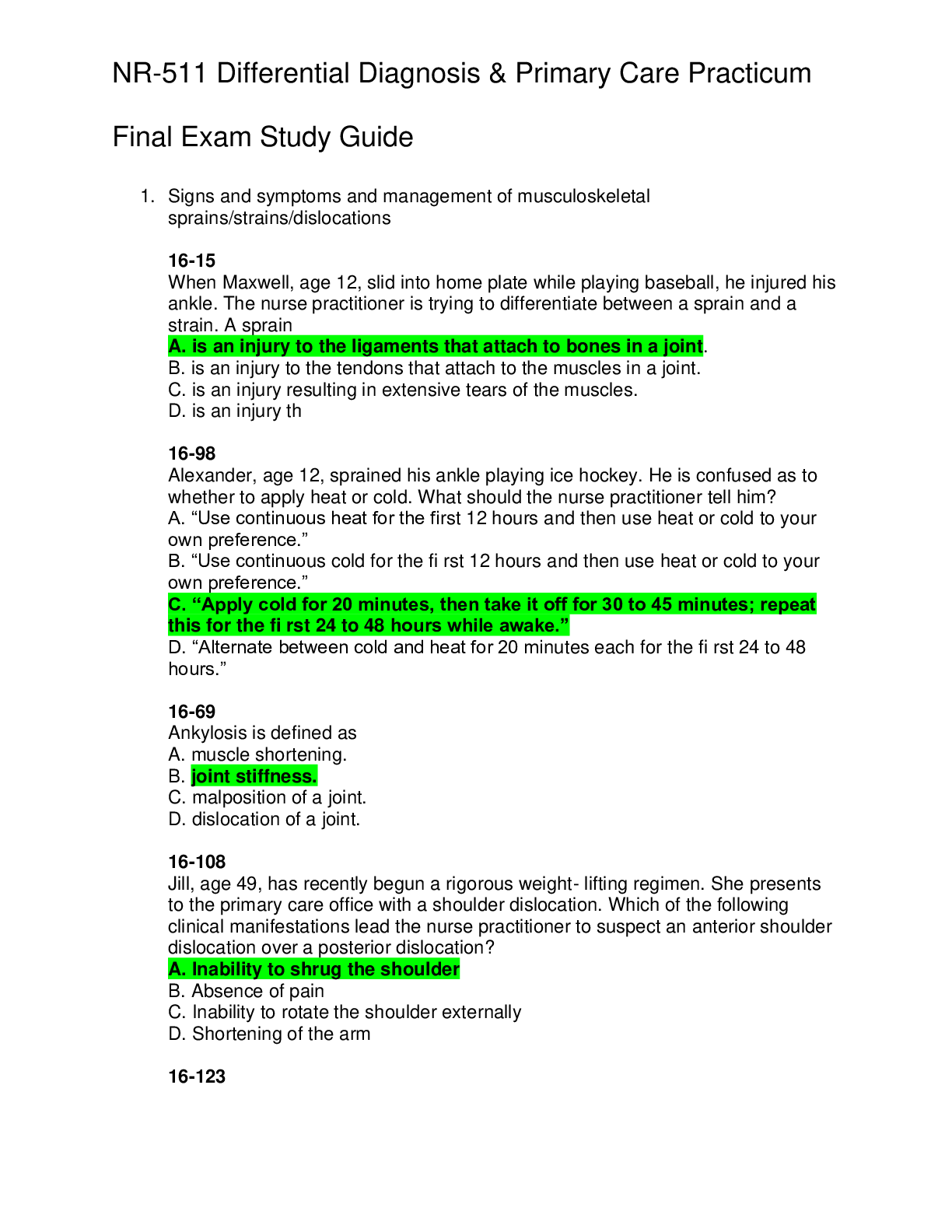
Buy this document to get the full access instantly
Instant Download Access after purchase
Add to cartInstant download
We Accept:

Reviews( 0 )
$14.50
Document information
Connected school, study & course
About the document
Uploaded On
Nov 14, 2020
Number of pages
31
Written in
Additional information
This document has been written for:
Uploaded
Nov 14, 2020
Downloads
0
Views
61

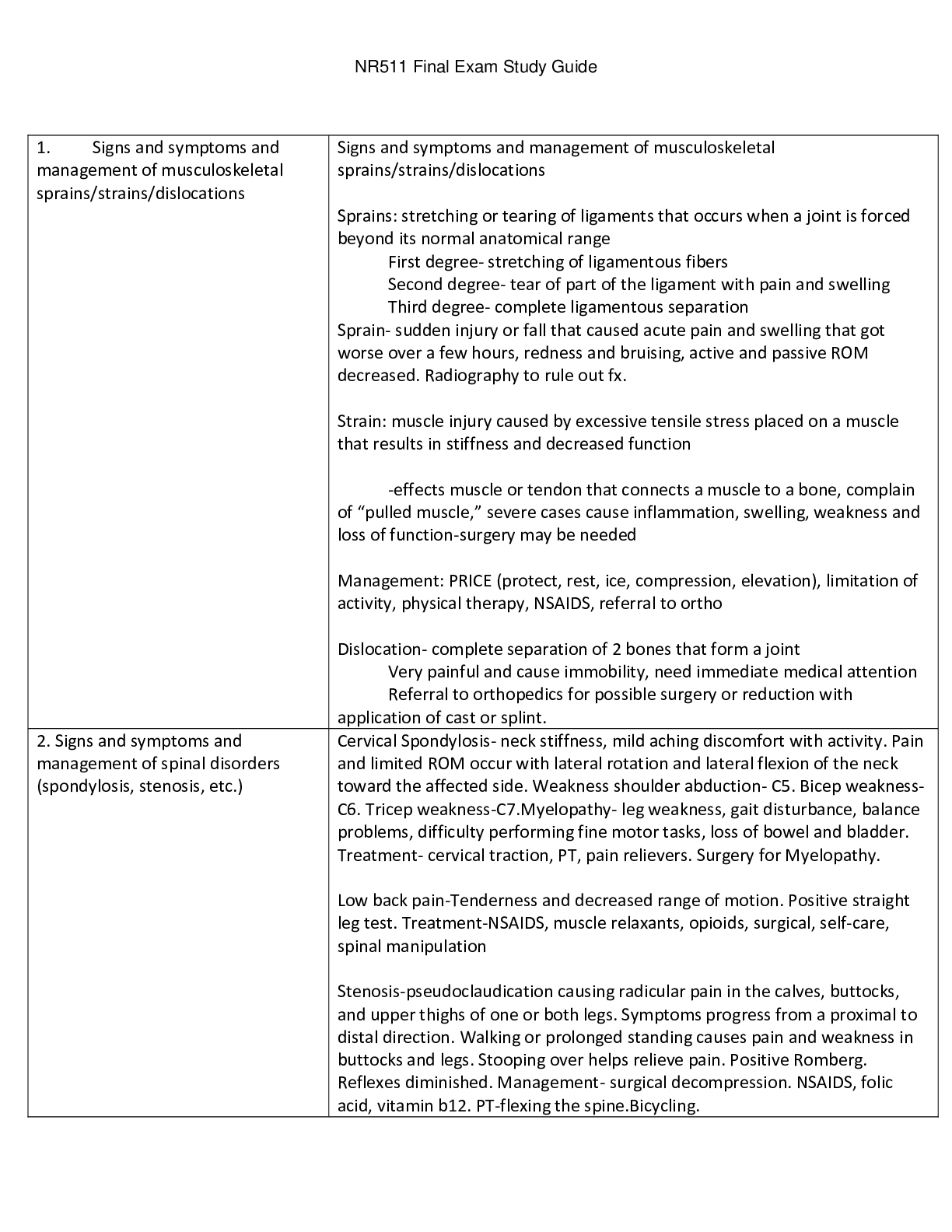
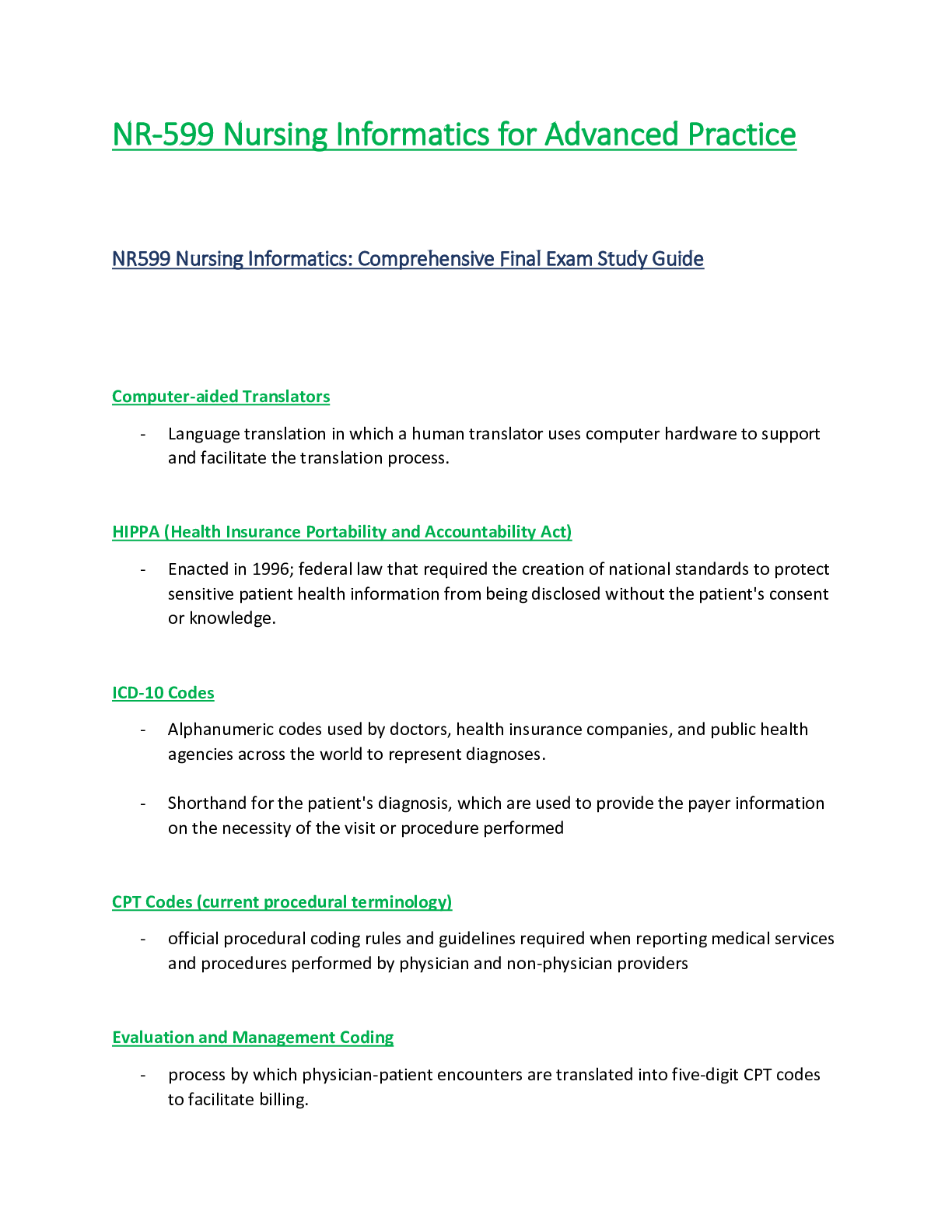
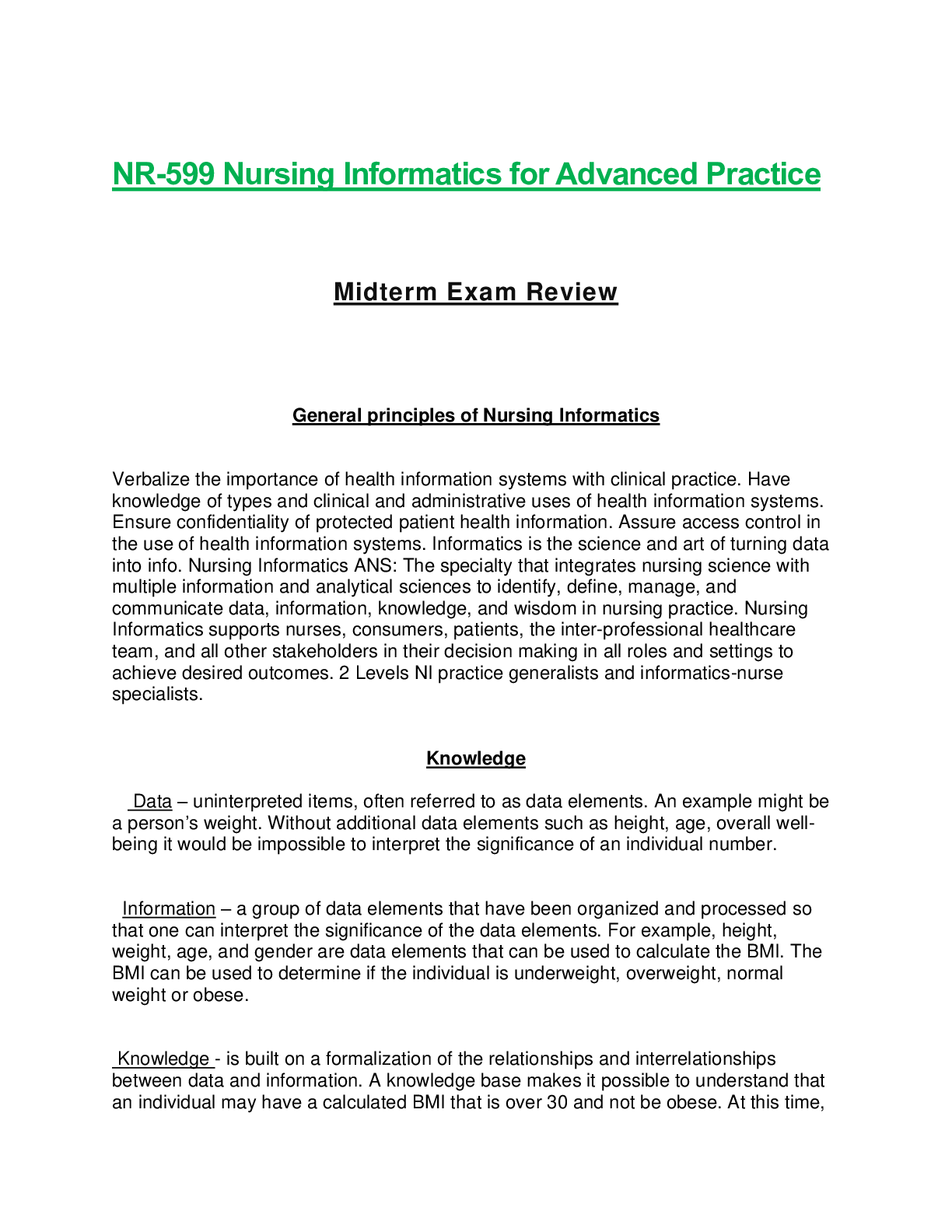



.png)

